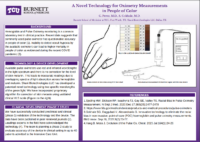
Innovative device tackles racial bias in health monitoring, ensuring accurate readings for all skin tones

Beyond improving diagnostic accuracy, this technology could potentially drive significant change in health equity, particularly in low-resource and underserved communities. This research is not only advancing science, it is shaping a more equitable future in health technology.
Research with real-world impact
- Health equity: Offers a transformative solution for underserved and low-resource settings, helping reduce racial disparities in diagnostic accuracy
- Global recognition: Accepted for presentation at the UNICEF/SAARC International Conference in Sri Lanka
- Academic endorsement: Attracted direct interest from Cornell University, NYC
- Funding success: Publication supported successful bid for prestigious NIH Phase 2 clinical study grant
- Global collaboration: Catalysed partnerships with leading researchers and institutions, accelerating technology development
- Research visibility: Cited 10 times in two years; six times higher than the field average
Career progression: Led to mentorship opportunities and a research faculty position for Dr Gokhale - Award recognition: Winner of the Anaemia Innovation Challenge for its breakthrough in non-invasive haemoglobin measurement

“The publication in BMJ Innovations has sparked unprecedented attention and conversation. Key stakeholders like the US Food and Drug Administration, policymakers, and device developers are now taking serious note of this unmet need.”
Dr Sanjay Gokhale
Physician turned bioengineer, and CEO of Shani Biotechnologies
Beyond improving diagnostic accuracy, this technology can potentially drive significant change in health equity, particularly in low-resource and underserved communities. Following the publication of this research, a Phase 2 Clinical Study, a grant from the largest public funder of biomedical research in the world, the National Institutes of Health (NIH), is underway to further validate the device.
Dr Gokhale stressed that the NIH grant review process is thorough and intense. One key parameter is whether the applicant has published any preliminary data in a peer-reviewed prestigious journal. Thus, he believes the BMJ Innovations publication proved crucial for his team in securing the grant. The publication also catalysed collaborations with global experts and stakeholders, including top researchers in the US and Italy, and advocates for racial equity in healthcare. These collaborations are vital to scaling the technology and ensuring it reaches all corners of the globe.
The development of this technology represents a significant advance in equitable healthcare. By addressing a critical gap in diagnostic accuracy, it has the potential to improve health outcomes for millions worldwide.
He adds that publishing in BMJ Innovations has amplified the visibility and credibility of this research. Having been cited 10 times, with all citations received within the past two years, reflects a 6.26x higher citation rate than the average for its field. Dr Gokhales has also witnessed frequent citations in major conference discussions, helping inform policy and practice globally.
Publishing in BMJ Innovations also brought unexpected professional growth. Dr Gokhale has been invited to mentor students and joined a university as a research faculty member. Dr Gokhale expressed how mentorship under BMJ Group’s Dr Ashley McKimm has been invaluable.
“Since our publication, we’ve formed robust partnerships with key opinion leaders, researchers, and policymakers across multiple countries… Our technology has reshaped the discourse around racial equity in pulse oximetry, and it’s gaining momentum in the medical community. It’s inspiring a broader push for more equitable diagnostic tools.
The publication in BMJ Innovations has played an instrumental role in generating visibility for my work. I have received an academic offer to join the University as a research faculty member and to mentor medical students. As a result of the publication, my interview was broadcast in the
local Dallas Fort Worth news media outlet!”Dr Sanjay Gokhale
Physician turned bioengineer, and CEO of Shani Biotechnologies
Publishing in BMJ Innovations has been a game-changer for Dr Gokhale’s team, catalysing a rapid increase in recognition, funding, and collaborations. The device, which eliminates racial bias in pulse oximetry and haemoglobin measurements, has the potential to directly shift healthcare diagnostics globally. With its ability to address a critical health equity issue, this technology is poised to change lives and save millions of patients from misdiagnosis and delayed treatment.
“This publication has been the springboard that has helped us turn a groundbreaking idea into a reality with global implications for health equity.”






